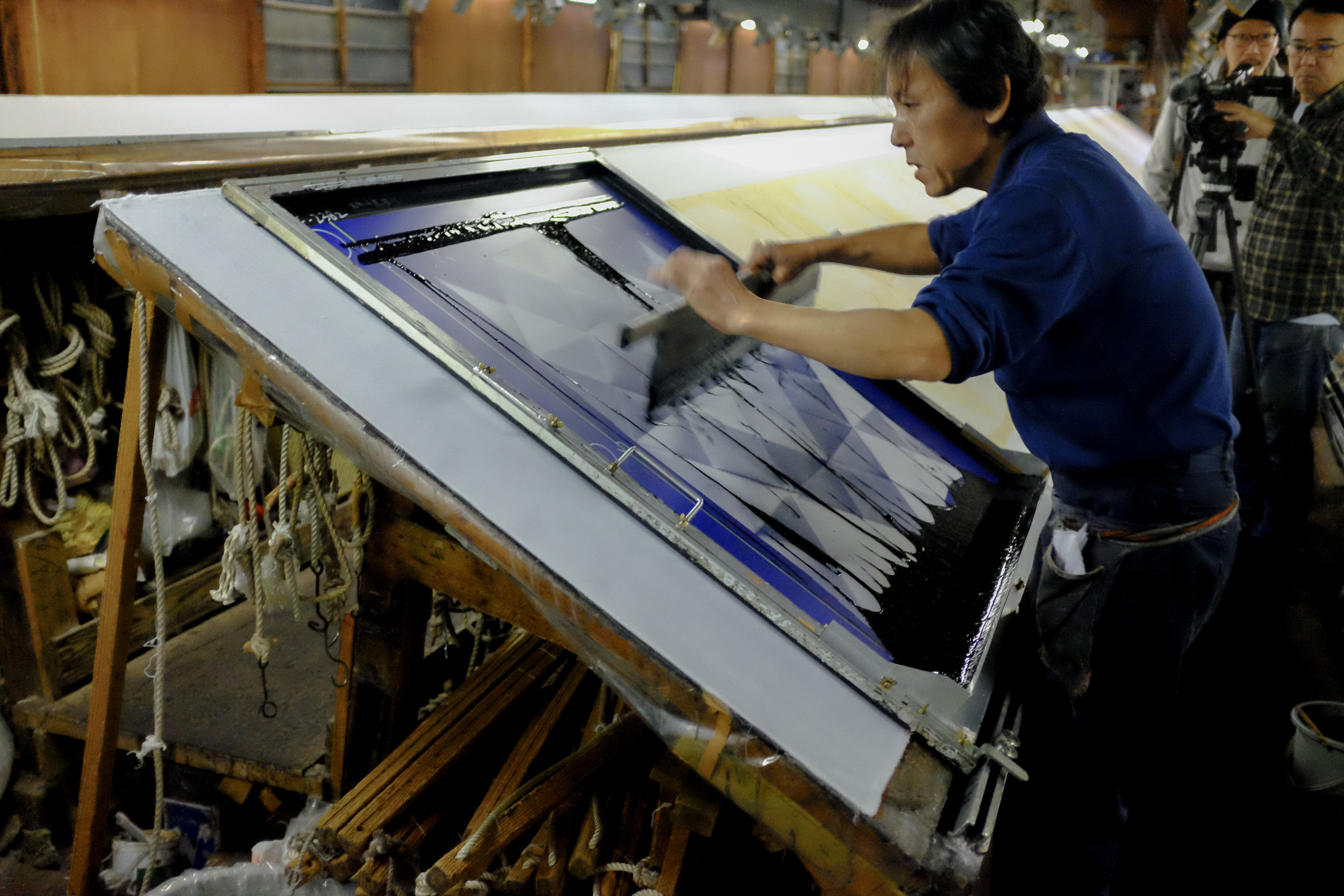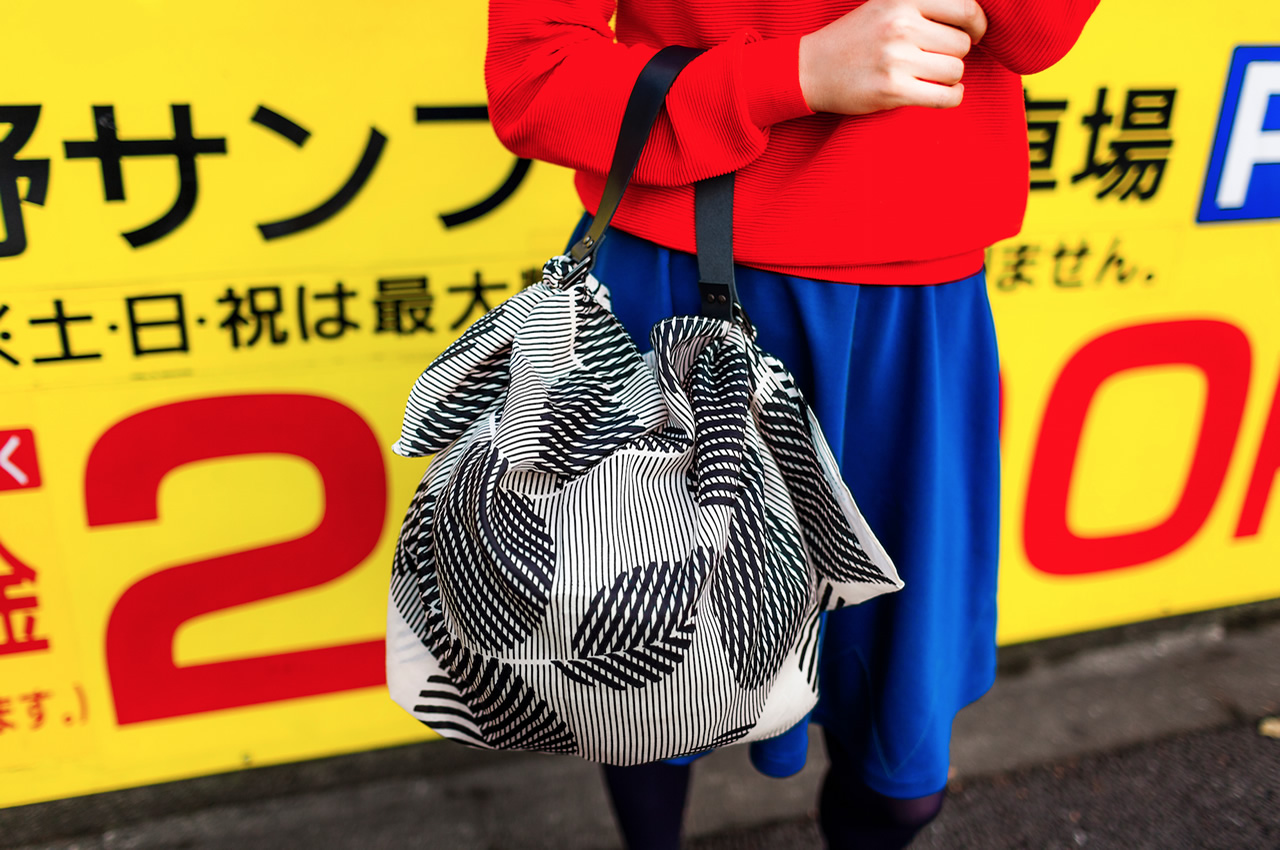Accompanied by Chiyumi Nogami
Part hosted by Mitsuyuki Tanaka of Chiffonez (acting agent to Furoshiki factory)
Kensuke Serizawa, writer for Great Gear on NHK World TV channel.
Based in the Fujisawa area of Tokyo
Furoshiki (pronounced fu-rosh-ki) is a cloth wrapping used to elegantly cover and carry anything. Traced beginnings in the 17th century this cloth is evident in many stores in Tokyo today, perhaps an indication of the unerring dedication to refined presentation.
Meeting Kyoko Bowskill half way, we travelled over an hour to the South East, outside central Tokyo. Close to the popular beach and coastal town of Kamakura, Fujisawa appeared to be a small suburban town of low level housing, small cabbage patches and outlying light industrial buildings.
This was my first chance to see craftsman at work, and try to understand the current textile print industry climate in Japan.
Behind a domestic home, with a discreet company sign (apparently a recent replacement of a more traditional one) was a one level 1950s building. Comprising of winding narrow walkways, offshoots of dark outer rooms storing row upon row of aluminium framed silk screens finally led to the print room.
What was distinctive about this textile print workshop were the details that differed from those I know back in the UK. Angled print tables of about 10-15 metres allowed for the ease of printing solo and better for the back. The screens were therefore tailored to these changes; with detachable ink well troughs (to counteract gravity), handles to easily manoeuvre the screens, thin light aluminium frames and slightly thicker dye pastes to avoid too much dripping.
There were three simultaneous production jobs on the tables, showing that the two printers and assistant were using every possible moment to complete work for different clients. They worked with deceptive ease and rhythm, a testament to their honed skills. Every part of the workshop space was in use; the tables tightly packed together, weighted pulley systems lifted the wet prints to the ceiling and freshly whisked reactive dye pastes for the day were laid out.
As Kyoko warned, the printers quietly continued on with their work, preferring to let Mitsuyuki Tanaka, their agent, discuss the details and process.
One of the biggest surprises to me was the factory divisions. When I asked Mitsuyuki Tanaka the location of the steamers (for dye fixing) he told me this is completed at a separate factory, something Kyoko suggested could be a hangover from the now dying kimono culture. But this is becoming problematic for two reasons.
Firstly, as demand dwindles the larger companies cannot maintain the staff or facilities. This luckily is something this family business is managing to stave off. Secondly, and I admit I was previously naïve of, is the impact of natural disasters. Through typhoons, earthquakes and tsunamis, factories often have to shut to rebuild or maintain machinery damaged, which then unavoidably passes delays onto the client. Particularly difficult considering the global market is obsessed with speed of production to maintain the fast fashion pace.
In the extremes of the terrible tsunami of 2011, the sewing factory Link Collective used was destroyed. The area around Fukushima and Miyazaki has always been a place where there were a lot of factories making Japanese clothing, but the terrible damage from the tsunami has made it very difficult to get things up and running again, even now.
Yet Link Collective is a success story for furoshiki. I asked Kyoko about this concept of value I’d been stewing over for the past few months, only to realise she had at least begun to crack this nut many years ago. She quickly recognised the higher level of desirability in the American, Australian and European market for hand crafted, exceptionally executed Japanese textiles and targeted her marketing to this audience. There was a fascinating moment near the end of our visit where Kyoko presented Mr Fukuda with a recent Link Collective booklet (this conversation was kindly interpreted to me by Chiyumi Nogami). Within the context of his own factory the Link Collective’s products were traditional textiles, but was amazed by how transformative through the graphics, styling and even the photography style the products became contemporary and ‘European’.
Link Collective products have many indications of uniqueness of Japanese refined textiles beyond the exceptional print quality. The cottons, I think, are shantung and particularly unusual to UK offerings. It is fine and smooth but with a starch-like strength, which must be why it makes a perfect furoshiki material - being robust enough to use as a bag or wrapping and soft enough to use as a scarf.
In fact, the story of Kyoko’s success with the brand meant we were joined by major Japanese television channel NHK for their ‘Great Gear’ programme. This was a second visit to film the printing, proving that sensitively approached contemporary interpretation of traditional skilled work is both valuable and the best approach for endurance.
Link Collective Furoshiki bag. Image curtesy of Link Collective
My absolute thanks go to Kyoko and everyone at the furoshiki factory for their generosity, insights and patience.









